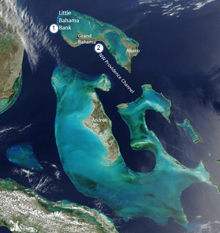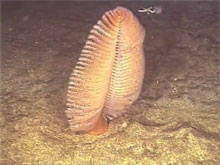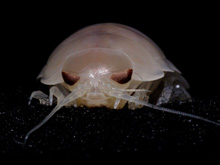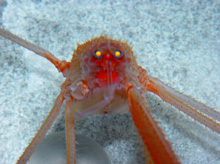Bioluminescence 2009:
Living Light on the Deep-sea Floor
Tamara Frank, PhD
Expedition Chief Scientist
Harbor Branch Oceanographic Institution/Florida Atlantic University
![]() Scientists observe a sea pen, Ptilosarcus sp., collected in the Galapagos.
Scientists observe a sea pen, Ptilosarcus sp., collected in the Galapagos.
![]() A deep-sea coral bioluminescing in response to agitation by the Johnson-Sea-Link II manipulator arm.
A deep-sea coral bioluminescing in response to agitation by the Johnson-Sea-Link II manipulator arm.
Bioluminescence is a fascinating phenomenon that is found in only a few species on land (e.g., fireflies), but is common in all the world’s oceans. It’s been estimated that 90% of the animals living in the pelagic (water column) are bioluminescent. However, information on bioluminescence in the deep-sea benthos (organisms that live on the sea bottom) is sparse, due to the difficulty in collecting live animals in trawls and dredges. An example of unique bioluminescence that foreshadows what remains to be discovered on the sea floor is found in the deep-sea sea pen (figure 1). In two instances, scientists were able to study the luminescence of specimens that were retrieved alive, and found that the bioluminescence of most of the stalk was green or blue/green, but at the distal tip of the stalk, the bioluminescence was blue.
Based on the few but varied deep-sea sessile (non-moving, like corals or sea anemones) animals that are known to be bioluminescent, and the very large eyes of some of the motile (independently moving) predators, it is likely that benthic bioluminescence is abundant and plays a significant role in animal interactions. An intriguing, and as yet unverified idea, is that when marine animals die and accumulate on the ocean floor, they may be covered with luminous bacteria. Bioluminescent bacteria occur throughout the marine environment, and these bacteria are known to colonize shrimp and fish carcasses, leading to the suggestion that the resulting background glow may be used as a cue by deep-sea scavengers to find carcasses.
This idea is supported by some work we did on the vision of some of these scavengers, called isopods (figure 2a) on Operation Deep Scope III ![]()
![]() . We found that their eyes work like a camera with a very slow shutter speed and are, therefore, extremely sensitive to light. However, as with a camera used in dim light with a very slow shutter speed, moving bioluminescent objects would be blurred. So these extremely sensitive eyes would be able to track only non-moving bioluminescence, such as an extremely dim glow from decaying animals that have been colonized by bioluminescent bacteria.
. We found that their eyes work like a camera with a very slow shutter speed and are, therefore, extremely sensitive to light. However, as with a camera used in dim light with a very slow shutter speed, moving bioluminescent objects would be blurred. So these extremely sensitive eyes would be able to track only non-moving bioluminescence, such as an extremely dim glow from decaying animals that have been colonized by bioluminescent bacteria.
In addition, data obtained on previous OE-funded expeditions indicate that the deep-sea benthos may produce novel, short wavelength bioluminescence. During Deep Scope 2005, we discovered that several species of the deep-sea crabs (figure 2b) have an ultraviolet (UV)-sensitive visual pigment in addition to a blue-sensitive one. In their dim light environment, sacrificing room in their eyes for a UV visual pigment suggests that UV sensitivity plays an important role in their ecology. Just as unusual UV sensitivity in several deep-sea pelagic species has been linked to bioluminescence, we suspect that UV sensitivity may also function to see as-yet-undiscovered short wavelength bioluminescence from benthic organisms. UV bioluminescence in the benthos may be a novel private channel of communication, allowing these animals to find their preferred habitat.
We are in the unique position of being able to use our combined expertise in bioluminescence, taxonomy, visual ecology, imaging, and molecular biology, together with the unique collecting capabilities of the Johnson-Sea-Link submersible to explore the deep-sea benthic environment for undiscovered “living lights.” We’ll be using a submersible-based low-light camera to photograph stimulated bioluminescence of animals in their natural environment. Most bioluminescence needs to be mechanically stimulated (i.e., most bioluminescent animals are not glowing constantly, but rather, respond with bioluminescence to some kind of mechanical and/or visual stimulus) and we will be able to stimulate them from the Johnson-Sea-Link without damaging the animal.
In addition, using very long shutter speeds in a stationary camera, we may be able to photograph bioluminescence that is too dim for our eyes to see. We will also be able to collect animals in temperature insulated light-tight bioboxes, allowing us to bring them to the surface alive for species identifications, further imaging of their bioluminescence, measurements of the color of their light, measurement of their visual physiology (if they have eyes), and molecular studies to look for new photoproteins that may be involved in producing any near-UV bioluminescence that we discover. We will also be deploying the Eye-in-the-Sea camera system to examine animal reactions to artificial bioluminescent prey.

Figure 3. This NASA satellite image of the Bahamas indicates the expedition's potential study sites.
Click
image for larger view and image credit.
We have chosen two potential locations for this expedition (figure 3). One of these along the western margin of Little Bahamas Bank, where there are relatively unexplored rocky lithoherms. These lithoherms are long rocky mound-like ridges that may be up to 50 m (164 ft) tall, rising up from depths of around 650 m (2,133 ft) in this area, and provide hardbottom for sessile species to settle on. There are a number of different sessile species here that would be prime candidates for our studies, but this location is also in the Florida current, which may result in bottom currents that might (1) make it difficult to stabilize the submersible for photography and (2) carry away any decaying matter and not allow it to accumulate.
If we find that this location isn’t optimal for our studies, we will move further east and south to Northwest Providence Channel, to a location that was last studied in 1978. While the abundance of animals is lower, more scavengers are found here, as bottom conditions are more favorable for allowing decaying matter to collect on the bottom.























